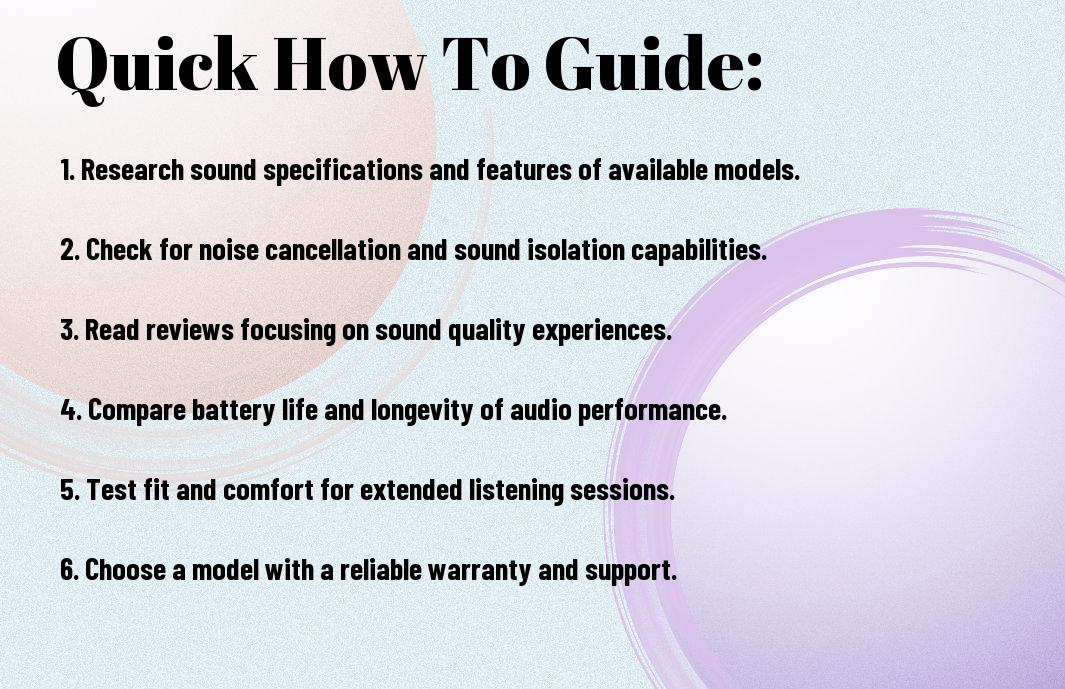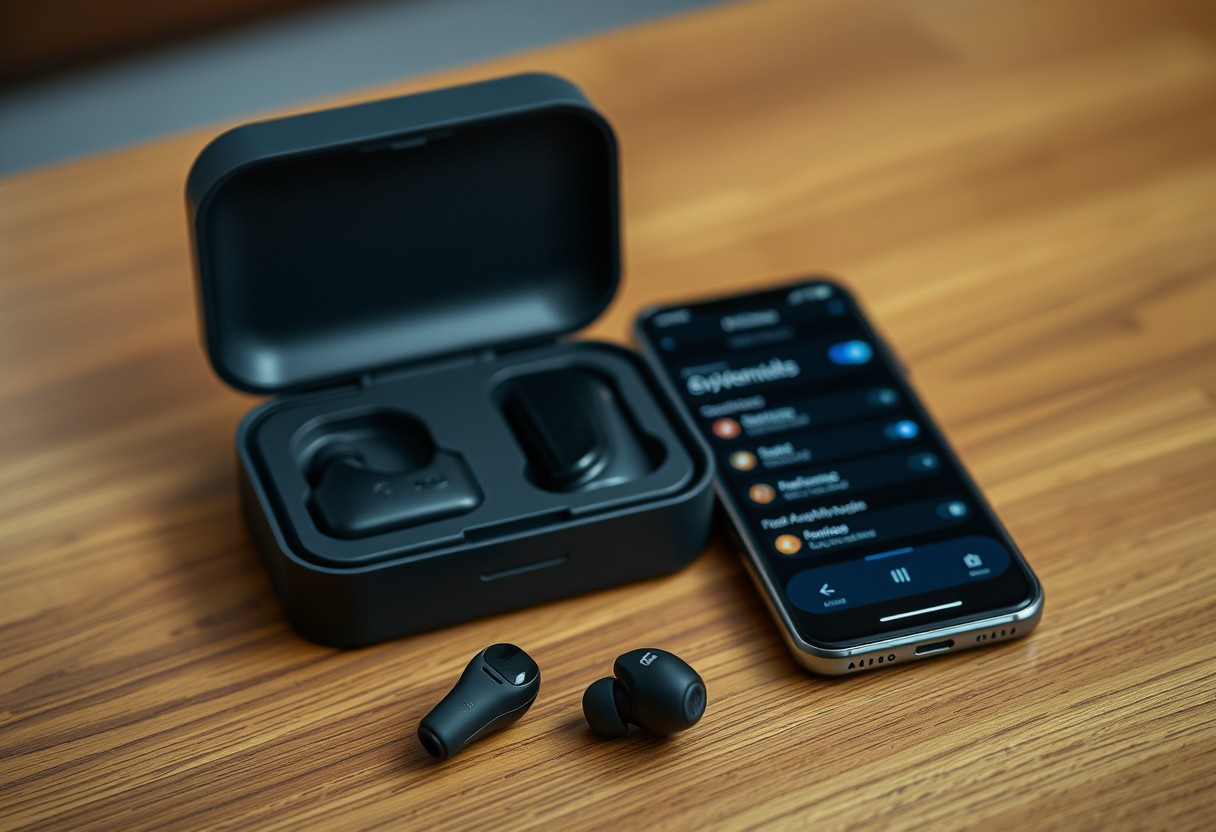Philips offers an impressive range of wireless earbuds designed for audiophiles and casual listeners alike. When choosing the perfect pair for optimal sound quality, I recommend considering factors such as driver size, which impacts bass performance, and Bluetooth technology for connection stability. You should also evaluate the earbud’s noise cancellation features, which can significantly enhance your listening experience. By following these guidelines, you can find the ideal pair that meets your audio preferences and elevates your sound enjoyment.
Key Takeaways:
- Sound Quality: Prioritize models that offer high-resolution audio for a richer listening experience.
- Battery Life: Look for earbuds with extended battery performance to enjoy longer listening sessions without interruptions.
- Noise Cancellation: Choose models with effective noise-canceling features for immersive sound and reduced ambient noise.
- Comfort and Fit: Ensure the earbuds come with various ear tip sizes to achieve a comfortable and secure fit during use.
- Connectivity: Investigate Bluetooth versions and compatibility for stable connections and seamless pairing with devices.

Understanding Sound Quality
A vital aspect of choosing the right earbuds is understanding sound quality. It encompasses various elements such as clarity, frequency response, and overall balance of audio. By grasping these components, you can better appreciate how your chosen earbuds will perform in delivering an immersive listening experience.
What is Sound Quality?
What defines sound quality is the ability of audio devices to reproduce sound accurately and pleasingly to the ear. This includes its clarity, richness, and dynamic range. When assessing sound quality, I pay close attention to how well earbuds handle different frequencies, from deep bass to crisp highs.
Importance of Sound Quality in Wireless Earbuds
Assuming you’re like me, you truly value an engaging audio experience. Sound quality plays an necessary role in how enjoyable your music or podcasts will be. With wireless earbuds, the absence of cords should not compromise audio performance, making it vital to choose a model that excels in sound reproduction.
Quality sound quality directly impacts how I perceive my favorite tracks. Good earbuds should balance all frequencies—this way, I can appreciate the depth of bass as well as the subtle nuances in vocals. If the sound is poor, I risk missing out on certain details and emotional connections in the music. Hence, ensuring your wireless earbuds have excellent sound quality will enhance your listening experiences, leading to greater satisfaction in your investment.
Key Features of Philips Wireless Earbuds
Any audiophile knows that the right features can make all the difference when choosing the best Philips Wireless Earbuds for optimal sound quality. Here’s a detailed list of key features to consider:
- Driver Size and Type: Look for dynamic drivers for rich sound quality.
- Frequency Response: A wider range ensures better sound reproduction.
- Noise Cancellation Technology: Active noise cancellation enhances listening experiences.
- Battery Life: Longer battery life means uninterrupted music enjoyment.
- Comfort: Earbud design impacts fit and sound isolation.
- Connectivity: A stable Bluetooth connection is necessary for a seamless experience.
- Controls: Touch or button controls should be intuitive and easy to use.
Recognizing these features will help you to select a pair that not only meets your sound quality expectations but offers an overall enriching experience.
Drivers: Size and Type
You might often hear that the driver size and type play a significant role in determining sound quality. Larger dynamic drivers typically provide better bass response and overall clarity, while balanced armature drivers are known for their accurate sound reproduction. (Choosing between these types depends on personal preference and intended use.)
Frequency Response: What to Look For
Clearly, frequency response is key for experiencing a full range of sounds. Look for earbuds with a wide frequency range, ideally from 20Hz to 20kHz, as this will ensure both deep bass and crisp high notes are delivered effectively.
Drivers play a major role in producing sound across different frequencies. Brands like Philips often excel in engineering their drivers to not only cover a wide frequency range but also deliver balanced sounds, allowing you to enjoy every detail in your music.
Noise Cancellation Technology
Assuming you desire a focused listening experience, look for Philips earbuds that incorporate active noise cancellation (ANC). This technology minimizes background noise, allowing you to enjoy your music without distractions.
Active Noise Cancellation works by using built-in microphones to pick up ambient sounds and generating sound waves that counter these noises. Philips’ implementation often results in a more immersive listening experience, making it an necessary feature for music lovers who frequent noisy environments.
Battery Life and Its Impact on Sound Quality
An adequate battery life is vital for uninterrupted listening. Philips wireless earbuds, known for their strong battery performance, can often provide hours of playback on a single charge without compromising on sound quality.
The battery life not only affects how long you can listen but also impacts the efficiency of sound processing. A strong battery ensures that the earbuds can consistently deliver sound at optimal levels, making it a significant factor in your listening experience.
Features like these outline what to prioritize in your search for the best Philips Wireless Earbuds. Balancing performance and personal preferences will lead you to a pair that truly enhances your daily listening.

How to Choose the Right Model
Keep in mind that selecting the right model of Philips wireless earbuds requires careful consideration of various factors that affect sound quality and overall experience.
Assessing Your Listening Habits
Assessing your listening habits is imperative to ensure you pick the right earbuds. Think about how and where you typically use earbuds—whether for workouts, casual listening at home, or daily commutes. Identifying these habits will help narrow down the features you prioritize, such as noise isolation or sweat resistance.
Matching Sound Signature to Your Preferences
Assessing the sound signature that matches your preferences is key to an enjoyable listening experience. Different models offer varying sound profiles, like enhanced bass or clear vocals. Testing out earbuds with diverse sound signatures could help you find your ideal fit for specific genres of music. (Choosing a model that complements your favorite music is an excellent strategy.)
Assessing further, it’s wise to read reviews and listen to sound samples to find the earmuffs that suit your tastes best. Different people have varying preferences, so take the time to explore models that align with the type of sound experience you desire. (Your musical tastes are unique; let those guide your choice.)
Importance of Comfort and Fit
Understanding that comfort and fit are vital is imperative when choosing earbuds. I can’t emphasize enough how poorly fitting earbuds can lead to discomfort, distracting you from your listening experience.
It’s also important to consider different ear sizes and shapes, as the right fit contributes to sound isolation and overall listening satisfaction. Earbuds that sit too loosely may fall out during movement, while ones that are too tight could cause discomfort over long periods. Prioritizing models that offer a variety of ear tips can help ensure a good fit and enhance your listening experience. Always bear in mind: fit is as important as sound quality.
Tips for Comparing Different Models
Unlike other audio devices, Philips wireless earbuds come in various models with unique features that can impact sound quality. When you’re making a decision, you should consider the following key aspects:
- Sound Quality – Pay attention to audio performance specs.
- Battery Life – Look for earbuds that offer long usage time.
- Comfort and Fit – Ensure they suit your ear shape for extended wear.
- Connection Stability – Check reviews for issues related to disconnection.
- Additional Features – Consider noise cancellation and touch controls.
This comparison will guide you to the best option that meets your audio needs.
| Aspect | Description |
|---|---|
| Sound Quality | Assess frequency response, bass performance, and clarity. |
| Battery Life | Compare how long they last on a single charge. |
| Comfort | Check for various ear tips and adjustability. |
| Connection Stability | Look for Bluetooth ranges and real-world performance. |
| Additional Features | Evaluate noise cancellation, voice assistant integration, etc. |
Reviewing Specifications and Features
There’s a wealth of specifications and features that can influence your final choice. Focus on the drivers, frequency range, and codecs supported by each model to ensure you get the best possible sound quality. (Picking the right feature set will enhance your listening experience.)
Unboxing and Initial Impressions
Some users find that the unboxing experience can greatly influence their perception of the product. Quality packaging, the presence of accessories, and the initial look of the earbuds can set the stage for your overall satisfaction.
A clean, well-organized package with user-friendly manuals and quality materials reflects the brand’s commitment to customer experience. First impressions, such as the weight and design of the earbuds, can sometimes indicate performance effectiveness.
User Reviews and Feedback
The feedback from other users provides invaluable insights into how the Philips wireless earbuds perform in real-world situations. Take the time to peruse reviews that highlight specific experiences, especially regarding sound quality and durability. (Understanding user feedback can help you avoid disappointments.)
People often share their experiences with sound performance, battery longevity, and ease of use. Evaluating these reviews carefully allows you to make a well-informed choice, steering clear of models that have common complaints.
Different models of Philips wireless earbuds rise and fall in popularity based on user satisfaction and overall performance. Considering both expert reviews and consumer feedback can significantly help you in choosing a model that fits your lifestyle and audio preferences.
Factors Influencing Sound Performance
Many aspects can influence the overall sound performance of your Philips wireless earbuds. Understanding these factors will help you make a more informed choice. Here are some key elements to consider:
- Source Quality: Streaming vs. High-Resolution Audio
- Bluetooth Codec: What Matters?
- Environmental Influences: Where You Listen
After evaluating these factors, you will have a better idea of how to achieve optimal sound quality with your earbuds.
Source Quality: Streaming vs. High-Resolution Audio
Quality of audio sources can significantly impact your listening experience. When streaming music, many services compress audio files, which can lead to a loss in fidelity. In contrast, high-resolution audio files offer a richer sound profile, allowing your earbuds to perform at their best.
Bluetooth Codec: What Matters?
On the topic of sound performance, the Bluetooth codec plays a vital role. The codec encodes and decodes audio signals during transmission, directly influencing sound quality. Different codecs, such as AAC, aptX, or LDAC, can offer varying levels of audio clarity and latency.
Source quality and Bluetooth codec compatibility are linked; higher-quality codecs can transmit better audio signals. If you’re using high-resolution audio files but your earbuds are limited to a less efficient codec, it can negate the benefits. Choosing earbuds that support advanced codecs will enhance your listening experience considerably.
Environmental Influences: Where You Listen
Streaming conditions can greatly affect sound performance. Listening in a noisy environment can interfere with sound clarity, causing you to miss details in your music. It’s vital to consider your typical listening spots to choose earbuds that provide effective noise isolation or cancellation.
To get the most out of your Philips wireless earbuds, select settings where you can minimize surrounding sounds. Outdoor environments, for example, may present challenges due to ambient noise. Investing in models that provide noise-canceling technology can significantly enhance the audio experience in various environments.
Maintenance and Care for Optimal Performance
Despite the impressive sound quality that Philips wireless earbuds offer, regular maintenance and care are necessary to ensure optimal performance. By following a few simple practices, you can extend the life of your earbuds while keeping their sound quality at its best.
Cleaning Your Earbuds
Performance can diminish if dirt and debris accumulate on your earbuds. I recommend gently wiping the surfaces with a soft, dry cloth after every use to remove dust and sweat. Avoid using strong cleaning agents, as they may damage the material.
Proper Storage Techniques
While it may seem easy to toss your earbuds into a bag, how you store them significantly affects their longevity. Consider using the charging case that comes with your earbuds when you’re not using them (this helps protect them from damage).
The way you store your earbuds can also impact battery life. I find that avoiding extreme temperatures and always keeping them in a case prevents accidental damage (this practice ensures they’re always ready for use when you need them).
Software Updates and Troubleshooting
To maintain optimal performance, I highly recommend regularly checking for software updates. Keeping your earbuds updated ensures that they function correctly and that you are taking advantage of the latest features and improvements.
Troubleshooting common issues is equally important. If you experience connectivity problems, resetting your earbuds or consulting the user manual may resolve the issue. Always ensure your earbuds are charged and within Bluetooth range to prevent frustrating drops in connection. By staying proactive with maintenance, you can enjoy your Philips wireless earbuds for years to come.
Conclusion
Conclusively, choosing the best Philips wireless earbuds for optimal sound quality involves evaluating factors such as sound profile, battery life, and comfort. I encourage you to consider your specific listening preferences and lifestyle needs when making your decision. By doing so, you’ll find earbuds that not only enhance your audio experience but also suit your daily activities. Ultimately, investing time in research will lead you to the perfect pair that delivers exceptional sound quality tailored for you.
FAQ
Q: What should I look for in terms of sound quality when choosing Philips wireless earbuds?
A: To ensure optimal sound quality, pay attention to the drivers’ size and type, frequency response range, and whether the earbuds support high-resolution audio. Larger drivers generally produce better bass and overall sound performance. Additionally, look for earbuds with specifications that cater to your preferred music genres.
Q: Are noise cancellation features important for sound quality?
A: Yes, noise cancellation can significantly enhance the listening experience by blocking out external sounds, allowing you to focus on the music. Active noise cancellation (ANC) technology is particularly effective for immersive sound quality, making it easier to enjoy audio without distractions in noisy environments.
Q: How does battery life affect sound quality when using Philips wireless earbuds?
A: While battery life doesn’t directly impact sound quality, a longer battery life allows for extended listening sessions without interruption. Ensure the earbuds have a competitive battery life to enjoy high-quality audio for hours. Frequent interruptions for charging can detract from the overall experience.
Q: Should I consider the earbud design and fit for sound quality?
A: Absolutely. The design and fit of the earbuds can influence sound isolation and, subsequently, sound quality. Look for options that provide a secure fit to minimize sound leakage and enhance bass response. In-ear designs typically offer a better seal compared to on-ear or over-ear models, leading to a more immersive experience.
Q: How can I decide between various Philips wireless earbud models for optimal audio performance?
A: Start by comparing specifications such as driver size, frequency range, and features like aptX support for higher quality audio streaming. Reading reviews and listening to demos in-store, if possible, can also help you assess the sound signature that best suits your taste. Additionally, consider any specific features that cater to your listening habits, such as water resistance or integrated voice assistants.



